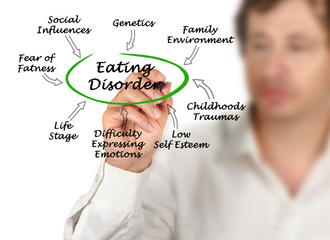Written By: Diana Winderman, LPC
Clinical Administrator at The Renfrew Center

Eating disorders are complex psychiatric conditions and various factors contribute to both the onset of the disorder and maintenance of its symptoms. Research suggests that the onset of an eating disorder seems to typically occur in adolescence or young adulthood, but they can actually be triggered at any age due to complex interactions between genetics and environmental risk factors.
Common Eating Disorder Types in Middle Age
Midlife eating disorders can present differently in everyone, however the most common are often symptoms of Anorexia, Bulimia and Binge Eating Disorder.
Anorexia
Anorexia consists of an intense fear of weight gain and symptoms of severe restriction to combat those fears. Regardless of body weight, restriction can cause severe psychological and medical complications. The denial or minimization that often accompanies Anorexia can be especially concerning as those who are suffering may not recognize the seriousness of their symptoms. Bulimia and Anorexia share similarities in that self-evaluation is highly influenced by body shape and weight.
Bulimia
Bulimia is characterized by episodes of binge eating an amount of food that is clearly larger than what most would eat, and the episode occurs within a discrete period of time. One typically reports feeling out of control during the binge. The binging is then followed by behaviors to compensate for it, such as self-induced vomiting, over-exercise, laxatives or diuretics.
Binge Eating Disorder
Binge Eating Disorder consists of recurrent episodes of bingeing. These episodes frequently include eating more rapidly than normal, eating until one is uncomfortably full or eating large amounts when not hungry. Binges cause significant distress and may take place in isolation due to intense feelings of embarrassment or shame. It is important to acknowledge that diets, food insecurity, delayed meals, as well as physical and mental restriction often maintain this disordered cycle.
Eating Disorder Risks for Middle Aged Adults
Eating disorders do not discriminate against age, race, size, shape, gender, or socioeconomic status. Everyone carries some level of risk for developing an eating disorder. Many individuals in midlife who are diagnosed with an eating disorder report a prior history of an eating disorder, body image dissatisfaction or disordered eating. Those in midlife can be especially vulnerable to eating disorders as the illness thrives in times of life stressors, biological changes and transitions such as:
- Separation or divorce
- ‘Empty-nest syndrome’
- Menopause and perimenopause
- Grief and loss
- Internalized biases (e.g., ageism, ableism and weight stigma)
- Chronic illness and injuries
- Career changes
These are just some of the many life stressors and experiences that are common in midlife. To make things worse, we live in a diet culture where youth and thinness is idealized, and it can feel impossible to live up to societal expectations.
Eating Disorders & Emotions
We know that eating disorders are emotional disorders and can be fueled by a desire to control distressing experiences. Many people who struggle with eating disorder symptoms are trying to avoid or seek temporary relief from uncomfortable or painful emotions. Midlife is known to be a period of transition which can lead to stress, anxiety, or depression, all of which are psychological risk factors and commonly co-occurring issues with eating disorders.
Home Dynamics
As eating disorders thrive during times of stress or transition, people in midlife can be at elevated risk for developing an eating disorder, experiencing a relapse in recovery, or reverting to disordered behaviors. Roles, routines and responsibilities within the family system may drastically shift when separating or divorcing from a partner, having children move out, retiring from a career, or caring for elderly family members. These transitions can increase feelings of loneliness and isolation. Changes in our support system and a loss of identity can contribute to fear, anxiety, and depression. The eating disorder may be a welcomed distraction or escape from these new stressors and emotional pain.
Body Image & Middle Age
In addition to possible changes in the home or family dynamics, the aging process may bring unwelcomed changes in the body. Body dissatisfaction, body image distortions and issues around eating can often be exacerbated by the aging process. Hormonal shifts with menopause may increase emotion dysregulation and feelings of vulnerability. Sadly, societal messages and social media platforms often equate youth, thinness and beauty with value. As we age and navigate these changes in our bodies, it can be easy to fall into a detrimental thought pattern that we are no longer worthy or valuable.
Treatment Options
Seeking treatment may be more difficult for those in midlife as feelings of guilt can arise due to leaving behind family members or pausing careers that rely on their presence every day. It is crucial that therapy is a collaborative process that is tailored to the unique needs of those in midlife. Partners, friends and family members can be powerful sources of support and healing and can be included in treatment with client’s consent. Renfrew encourages individuals thirty and older to explore their specific issues in a community of peers struggling with similar challenges around nutrition, wellness, relationships, exercise, and self-care. With the support of a group therapist, the Thirty Something and Beyond Group, also known as “TSAB”, is a safe space to share and process these unique midlife issues and concerns.
Conclusion
Eating disorders can strike at any age and it’s never too late to seek help. While people in mid-life are vulnerable to this illness, treatment can be successful, and progress can be sustained with continued support. Motivation to end years of suffering is typically high and desire to return to loved ones can be a driving force in the recovery process.
The Renfrew Center offers a supportive community of peers and trained clinicians to battle the disorder together. Eating disorders are powerful and can cause feelings of hopelessness. The battle doesn’t need to be fought alone and recovery is possible! For more information on The Renfrew Center’s midlife program, you can call 1-800-Renfrew or visit us online at www.renfrewcenter.com.



